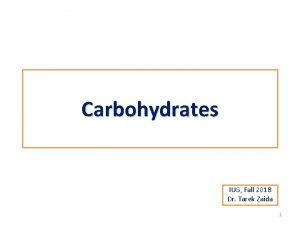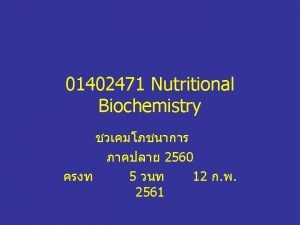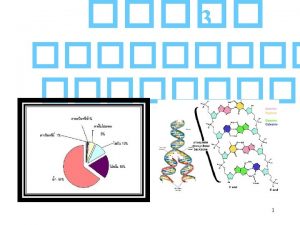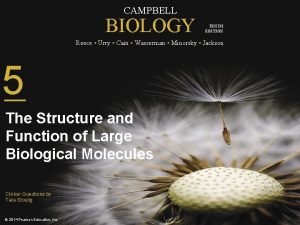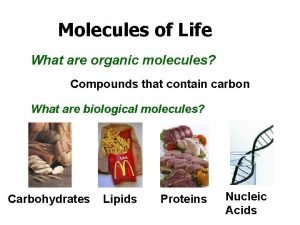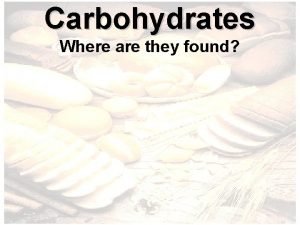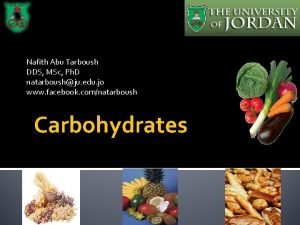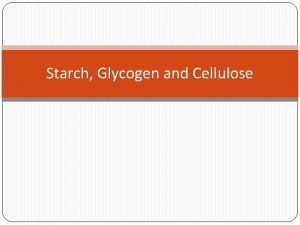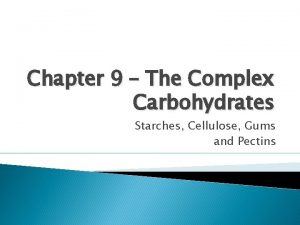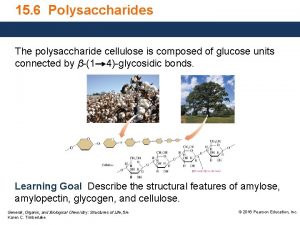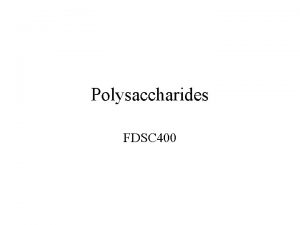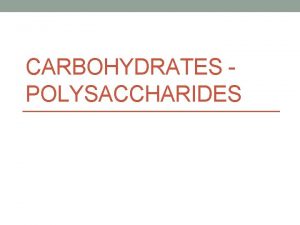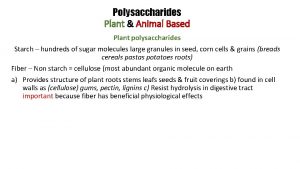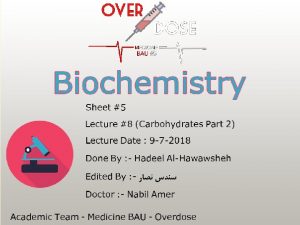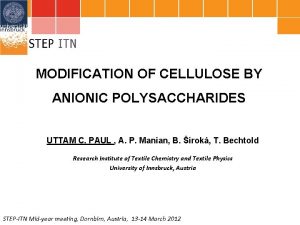15 6 Polysaccharides The polysaccharide cellulose is composed












- Slides: 12

15. 6 Polysaccharides The polysaccharide cellulose is composed of glucose units connected by β-(1 4)-glycosidic bonds. Learning Goal Describe the structural features of amylose, amylopectin, glycogen, and cellulose. General, Organic, and Biological Chemistry: Structures of Life, 5/e Karen C. Timberlake © 2016 Pearson Education, Inc.

Polysaccharides • are formed when many monosaccharides are joined together. • include amylose, amylopectin, cellulose, and glycogen, which are polymers of D-glucose and differ by branching and types of glycosidic bonds. General, Organic, and Biological Chemistry: Structures of Life, 5/e Karen C. Timberlake α-D-Glucose © 2016 Pearson Education, Inc.

Starch is • a storage form of glucose in plants, found as insoluble granules in rice, wheat, potatoes, beans, and cereals. • composed of two kinds of polysaccharides: amylose and amylopectin. General, Organic, and Biological Chemistry: Structures of Life, 5/e Karen C. Timberlake © 2016 Pearson Education, Inc.

Starch: Amylose, which makes up about 20% of starch, consists of 250 to 4000 α-D-glucose molecules connected by α-(1 4)-glycosidic bonds in a continuous chain. Polymer chains of amylose are coiled in a helical fashion. General, Organic, and Biological Chemistry: Structures of Life, 5/e Karen C. Timberlake © 2016 Pearson Education, Inc.

Starch: Amylopectin • makes up as much as 80% of starch. • is a branched-chain polysaccharide. • contains glucose molecules connected by α-(1 and α-(1 6)-glycosidic bonds. 4)- Starches hydrolyze easily in water and acid to give smaller saccharides, called dextrins, which then hydrolyze to maltose and finally glucose. General, Organic, and Biological Chemistry: Structures of Life, 5/e Karen C. Timberlake © 2016 Pearson Education, Inc.

Starch: Amylopectin In our bodies, these complex carbohydrates • are digested by the enzymes amylase in saliva and maltase in the intestines. • provide about 50% of our nutritional calories from the glucose obtained in digestion. General, Organic, and Biological Chemistry: Structures of Life, 5/e Karen C. Timberlake © 2016 Pearson Education, Inc.

Animal Starch: Glycogen is • a polymer of glucose that is stored in the liver and muscle of animals. • hydrolyzed in our cells at a rate that maintains the blood level of glucose and provides energy between meals. • similar to amylopectin but more highly branched. The glucose units in glycogen are joined by α-(1 4)glycosidic bonds, with branches attached by α-(1 6)glycosidic bonds that occur every 10– 15 glucose units. General, Organic, and Biological Chemistry: Structures of Life, 5/e Karen C. Timberlake © 2016 Pearson Education, Inc.

Cellulose, the major structural unit of wood and plants, • is a polysaccharide of glucose units in unbranched chains with β-(1 4)-glycosidic bonds. • cannot form hydrogen bonds with water, making it insoluble in water. • gives a rigid structure to the cell walls in wood and fiber. • is more resistant to hydrolysis than are the starches. • cannot be digested by humans because humans cannot break down β-(1 4)-glycosidic bonds. General, Organic, and Biological Chemistry: Structures of Life, 5/e Karen C. Timberlake © 2016 Pearson Education, Inc.

Cellulose The polysaccharide cellulose is composed of glucose units connected by β(1 4)glycosidic bonds. General, Organic, and Biological Chemistry: Structures of Life, 5/e Karen C. Timberlake © 2016 Pearson Education, Inc.

Study Check Identify the polysaccharides and types of glycosidic bonds in each of the following: A. General, Organic, and Biological Chemistry: Structures of Life, 5/e Karen C. Timberlake B. © 2016 Pearson Education, Inc.

Solution Identify the polysaccharides and types of glycosidic bonds in each of the following: A. Cellulose β-(1 4)-glycosidic bonds B. Amylose α-(1 4)-glycosidic bonds Amylopectin α-(1 4)- and α-(1 6)-glycosidic bonds General, Organic, and Biological Chemistry: Structures of Life, 5/e Karen C. Timberlake © 2016 Pearson Education, Inc.

Concept Map General, Organic, and Biological Chemistry: Structures of Life, 5/e Karen C. Timberlake © 2016 Pearson Education, Inc.
 Difference between monosaccharide and polysaccharide
Difference between monosaccharide and polysaccharide Storage polysaccharides
Storage polysaccharides Polysaccharide ประกอบด้วย
Polysaccharide ประกอบด้วย A polysaccharide you are studying contains unbranched
A polysaccharide you are studying contains unbranched Biological molecules
Biological molecules Monosaccharides disaccharides and polysaccharides
Monosaccharides disaccharides and polysaccharides Polysaccharides
Polysaccharides Ketotetrose
Ketotetrose Different types of saccharides
Different types of saccharides Structure of sucrose maltose and lactose
Structure of sucrose maltose and lactose Cellulose introduction
Cellulose introduction Glycogen vs starch vs cellulose
Glycogen vs starch vs cellulose Cellulose complex carbohydrate
Cellulose complex carbohydrate
